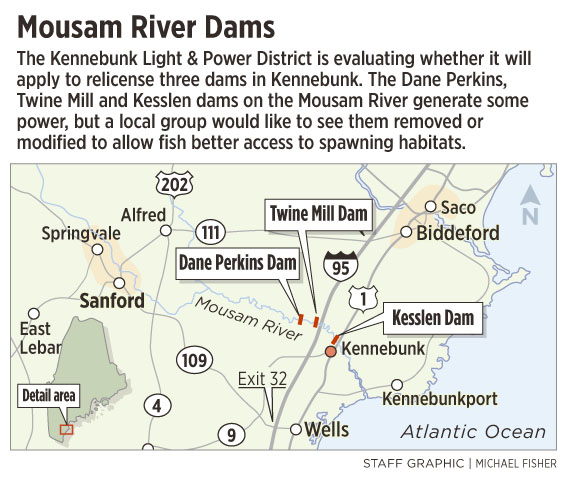For more than a century, a series of dams has prevented fish from swimming up and down the Mousam River as it wends its way through York County to the Atlantic Ocean.
Now, however, some conservationists and residents see a potentially historic opportunity to restore fish access to the lower portion of the waterway that once powered mills in Sanford and Kennebunk.
The future of three hydroelectric dams owned by the Kennebunk Light and Power District is headed toward a formal federal review. The district is just beginning to study the costs and benefits of keeping the dams, but a local group is hoping the dams will be removed or modified to allow migratory fish such as shad and alewives to move freely through the Mousam River as it flows through downtown Kennebunk.
“These dams were built for industry. There was little or no consideration for migrating species or the impact these dams had on the river,” said R.J. Mere, a Maine Guide from Kennebunk.
If the efforts are successful, the 23-mile-long Mousam River would join a growing list of Maine waterways undergoing restoration efforts that include dam removals and fish ladders.
In fact, discussion of the three dams on the Mousam River is occurring as one of the largest dam removal projects in North America continues on the Penobscot River. On Monday, the Veazie Dam in Eddington will be breached, part of a larger, multi-dam project to return native sea-run fish to the Penobscot.
Also this summer, the 200-year-old Randall Mill Dam is scheduled to be removed from the Royal River in Pownal. Sappi Fine Paper in Westbrook recently installed a $5 million fish ladder to expand migratory fish access to the Presumpscot River.
“The challenges the Mousam River faces are not unique. Most of our rivers in Maine and New England have a history of industrial use that is not healthy for creatures that lived in or along it,” said Landis Hudson, executive director of Maine Rivers. “There’s definitely a much greater understanding of the importance and value both environmentally and economically of free-flowing rivers.”
The Kennebunk Light and Power District, a consumer-owned, nonprofit entity, last week started the long process of analyzing whether it will apply to relicense the Kesslen, Twine Mill and Dane Perkins dams, which generate power in Kennebunk.
The license from the Federal Energy Regulatory Commission expires in 2022, but power district officials say they want to develop a plan by 2015 after two years of studies, analysis and input from the community. The plan could include relicensing the dams and installing fish passageways, surrendering the license and ceasing operations or removing the dams entirely.
Members of the Mousam and Kennebunk Rivers Alliance would like to see the three Kennebunk dams removed — or at least improved to include a fish passage system, said Mere, who is a member. He said the lack of fish passages prevents migration of shad, alewives, American eel, trout, elvers and Atlantic salmon.
“It’s notable that the Mousam River has a number of dams and yet no fish passage on any of them. That ranks pretty high in the state of Maine as far as the oddity of that,” Mere said.
There are a total of 13 dams on the Mousam River, which flows from Mousam Lake in Acton through Sanford and Kennebunk.
Mere said removing the three Kennebunk Light and Power dams or installing fish passageways over the dams would provide 17 miles of spawning habitat for fish.
The most visible of the three Kennebunk dams is the Kesslen, located next to the Lafayette Center on Main Street.
The Kesslen Dam was in place by the mid-1850s and has been generating electricity for the power district since 1893, said Sharon Staz, general manager of Kennebunk Light and Power.
Staz said the dams currently produce power to cover 1.3 percent of the district’s needs, though at times that number has risen to around 5 percent. An analysis of energy production from the dams will be done as part of the relicensing process, she said.
Any decisions about the dams will be made to meet Kennebunk Light and Power’s goal of developing a cost-effective plan that meets the needs of its customers and the wider community, Staz said.
Barry Tibbetts, town manager of Kennebunk, said town officials will closely follow the review and relicensing process because “it affects the town at many different levels.” If the district has to borrow money for dam-related projects, it will require a townwide referendum.
“(The Mousam River) runs right through the heart of our downtown and through some dense residential areas,” Tibbetts said, noting the town will have many questions about the economic and environmental impacts of removing the dams or leaving them in place. “I think it’s good this is starting early. It allows us time for review and for collective wisdom to come up with the best solution. That’s what we want for the community, the best solution.”
Gillian Graham can be contacted at 791-6315 or at:
ggraham@mainetoday.com
Twitter: grahamgillian
Send questions/comments to the editors.






Success. Please wait for the page to reload. If the page does not reload within 5 seconds, please refresh the page.
Enter your email and password to access comments.
Hi, to comment on stories you must . This profile is in addition to your subscription and website login.
Already have a commenting profile? .
Invalid username/password.
Please check your email to confirm and complete your registration.
Only subscribers are eligible to post comments. Please subscribe or login first for digital access. Here’s why.
Use the form below to reset your password. When you've submitted your account email, we will send an email with a reset code.